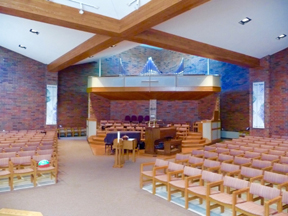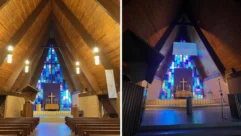
SVC Podcast – Show Notes – Show 140-2:
In this edition of the SVC Podcast, SVC Contributing Editor Bennett Liles wraps up his talk with Kevin Crow of Excel AV Group in Minneapolis. Kevin provides more details on the dual sound system setup installed for the Good Shepherd Lutheran Church which has brick walls and a huge physical separation between the choir and the altar area. He outlines the acoustical challenges and discusses the band monitoring system.
Links of interest:
- Excel AV Group in Minneapolis, Minnesota
- Fulcrum CX1526 15in. coaxial loudspeakers
- Allen & Heath Qu-24 mixing console
- Turbosound monitor wedges used by the choir
Download Podcast Here:
https://s3.amazonaws.com/nb-svc/public/public/140-2_Excel_AV_Group_Good_…
From Sound & Video Contractor Magazine, this is the SVC Podcast with Kevin Crow. Show notes for the podcast are available on the web site of Sound & Video Contractor Magazine at svconline.com.
At Good Shepherd Lutheran Church the choir, altar and musicians are spread out across the room, and getting the sound right required two separate systems. Kevin Crow with Excel AV Group is here to tell us how that design came up, and how they got it all to work. That’s up next on the SVC Podcast.
Kevin, thanks for being back with us for Part 2 on the SVC Podcast from Excel AV Group in Minneapolis, and in Part 1 we were talking about the Good Shepherd Lutheran Church up there in your area. Lutheran churches are known for sometimes having some very interesting architecture. You told us in Part 1 that you wished they hadn’t been quite so creative in their layout. There’s a lot of music in this church, so how do the musicians do their monitoring?
So this is one of the battles that I think a lot of integration companies that specialize in churches deal with. Certainly my company deals with this on a very, very regular basis and that is how do you reduce the stage volume or the music area volume levels to the point where it’s manageable? The biggest problem areas are like drummers and base players and guitar players that have acoustic drum sets, or they’ll have big bass amps and then they’ll have guitar cabinets and things like that. And what we’re trying to do with these individuals is teach them that if they wear either headphones or earbuds, that they can actually not only hear better what their mix is and their music is, but they can actually play better together as a team. And I have first-hand experience doing that myself as a former music leader. So the solution that we typically go with to help them with that are the personal monitor mixes. So in this case we have the Allen & Heath Qu-24 mixer and we added the ME-1 personal mixing systems to the project. And the ME-1’s allow each musician that uses one of the mixers to have their own mix to be able to mix in not only reverb, but also the ambient sound in the area. And we find that if we can get people to actually do that and get them off the monitor wedges that they play better, it reduces the overall level in the music area, and the sound is much more natural and manageable in the space. [Timestamp: 2:55]
Yeah, it seems especially true in churches where you have live music. Once they’ve gotten into using in-ear monitoring they’ll never go back.
Right. They don’t. And that’s the thing that I noticed back in the day when I used to audition. I played drums, so I can pick on myself here, but drummers are the worst. They just are. You bring them in, you audition them, they can actually keep time and you want them to play for you, but think that this is jam night and it’s not jam night. You’re serving in church. You’re here to do that. And so usually they would be demanding a monitor wedge and I would tell them look, if you just give me one or two or three services with a personal mixer such as the Allen & Heath ME-1, just give me this. And they would always come back and were so excited and would say, “Wow, I can hear everything so much better, so much clearer. I can play better. I can keep time better,” all of it. So it’s a great solution, really. [Timestamp: 3:55]
And I think that one thing we didn’t talk about in Part 1 is the Danley subwoofer. In a space like that it can make all the difference in the quality of the sound for the congregation.
Well, yeah. You know a lot of sound companies, I think, chintz on the use of subwoofers and I think that’s a mistake. I mean if you look at all of the content from bass guitars for – just the standard kick drum is typically around 55-60 Hz. If you’re doing contemporary music at all, or if you want to have video playback of music or effect, you have to have a subwoofer. And even if the space is not acoustically dead like this one, it’s still, for the content you really do need to have a subwoofer. And the nice thing about the Danley subs is they’re compact, they’re efficient, and they just respond so well and this kind of application is just perfect for them. That’s a single 12-folded horn subwoofer, so a single 12-inch driver in that one sub. [Timestamp: 5:02]
And the Danley systems are known for being tough and durable. This one probably doesn’t get very rough treatment but I’ve seen them used in sports stadiums outside and just keep right on ticking. Now one very interesting aspect to this one is the iPad control capability. Did this require you to train anybody in the operation?
I think that if they can run their microwave they can pretty much run this, and that’s the point of touch-panel control systems, period. In this particular application we’ve got a key digital compass control which is very affordable, and we’ve got control of the sound system on/off. We’ve got the easy mix like we talked about in Part 1. We’ve got the video projection system, the screen up/down. We’ve got the projectors on/off, the source selection for the projection. So when we lay out the touch-panel control it’s easy to use and it’s simple and that’s what it needs to be. [Timestamp: 6:02]
One of the things I saw on this that kind of got my attention that the band and everything else in there is running on a surprisingly low power draw. How did you manage to get away with that?
I think the biggest thing is that this in an old building and we don’t have the luxury of being able to bring in a lot of new circuits. So we found out that we had two 20-amp circuits to work with and we’ve got all of our sound and video equipment in the music area on that. And because we’re using the PowerSoft M50Q, there’s just such low power requirements for the entire system it’s amazing. And digital mixers, for that matter, also use very low power. [Timestamp: 6:43]
Yeah, and I would imagine that in the church environment with nobody specifically trained to operate the sound that one big ace in the hole for a digital mixer is the ability to push one button and get it back to where it was.
Yeah. The scene recall ability is a huge deal.
And the architecture on this church looks as though running cables and keeping them out of sight might have presented a problem.
It was a nightmare. This was in the top 10 worst ones I’ve ever seen for moving wire around and getting it where it needed to go. But my team is amazing. They seem to always figure out how to do it. I don’t know how, but that’s what I pay them for, so they do it. [Timestamp: 7:19]
So in this situation with everybody separated across the room did timing in the monitoring get to be an issue?
Well, the musicians and the choir are together, but an application where it would be a challenge is if there was a singer that decided to sing from the front like at the altar or the podium position. But we do have a way to route that vocal to the mains if we need to, and trained the client to do that. But so far they have not really requested that and the choir and the music people are pretty close to each other in that area. [Timestamp: 7:55]
This is being referred to as an exploded mono system. Is that the best for this sort of space?
Absolutely. Typically the only time that we do stereo or left-center-right is if we have more of a theater shoebox-type layout. This is not that at all. This is a square box that everybody’s sitting in essentially a circle. And in that kind of a situation you have to keep in mind that most all of the inputs into a sound system like this are mono anyway; spoken word, all the instruments – except for perhaps a digital keyboard – is going to be mono. So because of that it’s a mono system and it makes sense to do that. [Timestamp: 8:35]
Makes things a lot easier. I was thinking that the only time any stereo would come into play is if you were going to play back some stereo music which I guess they don’t do much.
Well, yeah, they don’t. And plus the cost to do stereo is so much higher than mono that it’s very little benefit for just that one application to put all the money towards stereo.
Well, I know this was an interesting, if somewhat hair-raising, project at times but it looks like everything worked out fine so what are your guys doing now? What’s coming up next for Excel AV Group?
Well, we’re pretty excited because we just finished – or we’re just completing it, actually, right now – a 15-foot-wide LED video wall in a church and it’s fantastic. They have huge windows in there, tons of ambient light. And this Chauvet S3 LED wall is spectacular in that room. And we’re excited about that. We’re just finishing that and we’ve got some other contracts coming up that are going to be similar to this one. We’re also working with some hospitality and casino clients on some different ballrooms and things like that and we’ll definitely be using PowerSoft amps for those. [Timestamp: 9:49]
Got a lot of experience doing that and with this Good Shepherd Lutheran Church being kind of unusual, that always adds to the playbook, and thanks for outlining it for us. It’s Kevin Crow from Excel AV Group in Minneapolis and a sound upgrade for the Good Shepherd Lutheran Church. Thanks for telling us about it.
Absolutely. Thank you, Bennett.
Thank you for being here with us for the SVC Podcast with Kevin Crow. Show notes are available on the website of Sound & Video Contractor Magazine at svconline.com. Join us again next week for the next SVC Podcast.










